I am trying to make a program in MVVM which can read Excel files and generate the content into a Word file. Now I am stuck at making new Tabs on a UserControl, every time someone chooses to create a Word file on the checkbox:

It should generate a new tab on my second UserControl which I am trying to generate from my ViewModel called HauptfensterViewModel.

The code in the view-model looks like this:
protected void OnWeiterExecute(object obj)
{
OnDokumentChanged();
new VorschauViewModel(view);
if (Dokumenttyp[0] == true)
{
//TabItem auf VorschauWindow erstellen, mit jeweiligem Dokumentennamen(Angebotsvorlage)
}
if (Dokumenttyp[1] == true)
{
//TabItem auf VorschauWindow erstellen mit jeweiligem Dokumentennamen(Auditplan)
}
if (Dokumenttyp[2] == true)
{
//TabItem auf VorschauWindow erstellen mit jeweiligem Dokumentennamen(Checkliste)
}
if (Dokumenttyp[3] == true)
{
//TabItem auf VorschauWindow erstellen mit jeweiligem Dokumentennamen(Dokumentationsvorlage)
}
}
I appreciate your help and I will try to answer all questions if there is something not understandable.